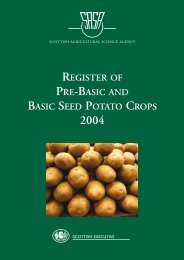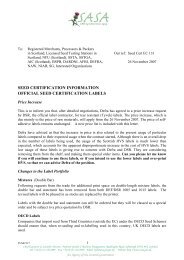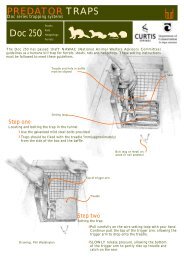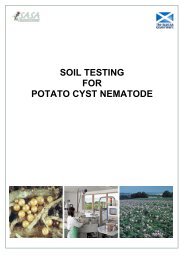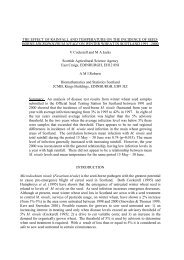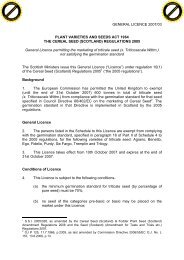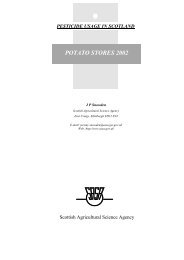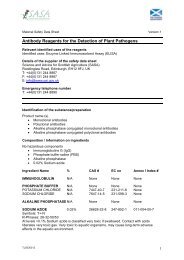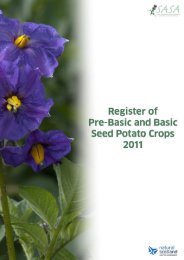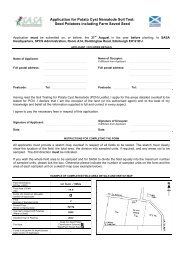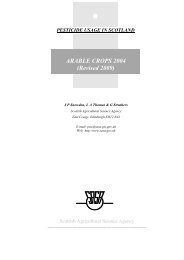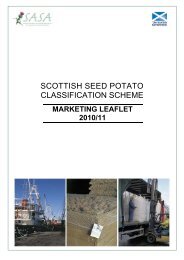2012 Scottish honey bee health surveillance report
2012 Scottish honey bee health surveillance report
2012 Scottish honey bee health surveillance report
Create successful ePaper yourself
Turn your PDF publications into a flip-book with our unique Google optimized e-Paper software.
The <strong>2012</strong> <strong>Scottish</strong> Honey BeeHealth Surveillance ReportMay 2013Stephen Sunderland, Alison Knox and Fiona Highet
EXECUTIVE SUMMARYAim:Approach:To assess the <strong>health</strong> status of <strong>honey</strong> <strong>bee</strong>s in Scotland and to gain a betterunderstanding of how factors such as husbandry and disease epidemiology affectthem. This information is required to evaluate and inform <strong>honey</strong> <strong>bee</strong> <strong>health</strong> measuresdeveloped within the <strong>Scottish</strong> Honey Bee Health Strategy.In <strong>2012</strong>, a random apiary survey was instigated by the <strong>Scottish</strong> Government’s AnimalHealth branch. From a randomised sample of 80 <strong>bee</strong>keepers registered on BeeBaseas keeping <strong>bee</strong>s in Scotland (10% of those registered at the time of sampling), 65took part in all aspects of the survey. The survey consisted of a questionnaire,inspection of all colonies within the apiary, testing of a sample of 30 adult <strong>bee</strong>s fordisease symptoms and one week’s collection from a hive debris trap. A further shortquestionnaire was completed in spring 2013 to establish colony losses during thewinter which followed sampling.The survey results have shown that –An ‘average <strong>Scottish</strong> <strong>bee</strong>keeper’ has <strong>bee</strong>n <strong>bee</strong>keeping for less than 10 years, managesfive or fewer colonies and produces 20-29lb <strong>honey</strong> per colony annually.39% of <strong>bee</strong>keepers questioned lost at least one colony during winter 2011-12 and 79% of<strong>bee</strong>keepers lost at least one colony during winter <strong>2012</strong>-13. Risk factors identified by<strong>bee</strong>keepers were environmental conditions (weather), queen <strong>health</strong>, starvation and Varroamites.Foulbrood disease and other notifiable pests of <strong>honey</strong><strong>bee</strong>s were not found out-with areasof known disease.A small pocket of American Foulbrood (a notifiable disease of <strong>honey</strong> <strong>bee</strong>s caused by thebacterium Paenibacillus larvae) was found in Inverness-shire during the survey (within aprevious outbreak area). Resources were deployed to eradicate this outbreak and inspectcontact colonies for signs of the disease.Varroa mites were present in all nine ‘regions’ inspected, although smaller areas of ‘Varroafreedom’ may still be present within Scotland.Nosema and Acarine disease were detected at lower levels; Nosema ceranae (a relativelynew disease to <strong>Scottish</strong> <strong>honey</strong><strong>bee</strong>s) is relatively well established and was found insamples from five of the nine regions tested.TLP040513 1
TLP040513 2
INTRODUCTIONThe European <strong>honey</strong> <strong>bee</strong>, Apis mellifera, contributes directly to food production and makes animportant contribution through pollination to crop production and environmental services. Since theintroduction of the Varroa mite (Varroa destructor) in 1998, <strong>Scottish</strong> <strong>honey</strong> <strong>bee</strong>s have <strong>bee</strong>n undersignificant disease pressure. An outbreak of European foulbrood (a notifiable disease caused bythe bacterium Melissococcus plutonius) identified in 2009 brought further disease pressure to<strong>Scottish</strong> <strong>honey</strong> <strong>bee</strong> colonies. The <strong>Scottish</strong> Honey Bee Health Strategy, launched in June 2010,formalised a partnership between the <strong>Scottish</strong> Government (SG), the <strong>Scottish</strong> Beekeepers’Association (SBA) and the Bee Farmers’ Association (BFA) committed to the <strong>health</strong> and welfare ofmanaged <strong>honey</strong> <strong>bee</strong> populations in Scotland. In order to achieve the aims of the Honey BeeHealth Strategy, the SG instigated a <strong>honey</strong> <strong>bee</strong> <strong>health</strong> survey in <strong>2012</strong> to develop an understandingof husbandry practices in Scotland and establish base levels of disease across the country.Results of the first year of <strong>surveillance</strong> are <strong>report</strong>ed and discussed.SAMPLING STRATEGYA total of 80 <strong>bee</strong>keepers (10% of those registered on BeeBase at the time of sampling) from9 regions were identified to take part in this survey. However, some were unable to providesamples for all aspects of the survey; where this is the case the number of <strong>bee</strong>keepers/regionssurveyed has <strong>bee</strong>n identified within the text.METHODSApiary inspection and questionnaireA random sample of 80 <strong>bee</strong>keepers was selected from 800 <strong>bee</strong>keepers registered on BeeBase askeeping <strong>bee</strong>s in Scotland (BeeBase is a voluntary and confidential computerised register of<strong>bee</strong>keepers managed by the National Bee Unit at FERA, York). These were divided intogeographical regions and contacted by their local SG <strong>bee</strong> inspector to request participation andarrange a date for inspection. A total of 65 <strong>bee</strong>keepers out of the 80 <strong>bee</strong>keepers selected took partin the apiary inspection and questionnaire. On arrival at the apiary, the <strong>bee</strong> inspector used theattached questionnaire (appendix 1) to establish levels of experience, training and methods ofhusbandry used.The apiary (or a representative apiary if the <strong>bee</strong>keeper owned more than one apiary) was fullyinspected for signs of notifiable diseases (European Foulbrood, American Foulbrood, Small HiveBeetle, Tropilaelaps spp. mites) by the Bee Inspector. A full inspection means that every colonywithin the apiary is visually examined for signs and symptoms of pests and disease. If a notifiabledisease was suspected by the Bee Inspector, then a sample was taken for confirmation by the <strong>bee</strong>diagnosis laboratory at Science and Advice for <strong>Scottish</strong> Agriculture (SASA). In the case ofAmerican Foulbrood (AFB) or European Foulbrood (EFB), an antibody based ‘test kit’ could beused on site for rapid diagnosis, followed by laboratory analysis at SASA of a sample of larvae forfinal confirmation. Whilst present at the apiary, the SG Bee Inspector collected a sample of 60<strong>bee</strong>s from the entrance of a representative hive and placed a debris trap in the hive floor forremoval by the <strong>bee</strong>keeper after one week. The <strong>bee</strong>s were killed by freezing at -20°C for at leastone hour, and both samples were sent in turn to SASA for analysis.TLP040513 3
courtesy of www.highlandphoto.org.ukLaboratory testsFoulbrood disease diagnosisIf the Bee Inspector found dead brood (larvae) during apiary inspections, a larval samplewas removed from the brood comb and placed into an eppendorf tube. At SASA thesample was analysed for the presence of the bacteria Melissococcus plutonius andPaenibacillus larvae, the causative agents of European Foulbrood (EFB) and AmericanFoulbrood (AFB) respectively. A sample of diseased tissue was removed from the deadlarva using a sterile plastic loop and mixed with a drop of distilled water and 4% nigrosinedye on a glass microscope slide. The slide was then fixed by drying on a hotplate andexamined for the presence of bacteria using high power microscopy at x1000magnification. A proliferation of bacteria morphologically identical to positive controlmaterial held within the lab (as determined by trained diagnosticians) was considered to bea positive result.Adult <strong>bee</strong> disease diagnosisThe sample of 60 adult <strong>bee</strong>s was received into the lab and 30 were immediately subsampledand stored at -80°C for PCR testing at a later date. Each <strong>bee</strong> from the remaining30 adult <strong>bee</strong>s was then individually examined for visual symptoms of Varroa destructorinfestation (an external parasite) and Acarine disease (scarring of tracheae indicative ofinfestation of the internal parasitic mite Acarapis woodii) using a binocular microscope atx10 - x40 magnification. Following examination, all 30 <strong>bee</strong>s were then placed in a ‘Biorebauniversal sample bag’ and 15ml distilled water added before the sample was crushedgently to extract the contents of the <strong>bee</strong>s’ guts and mixed by gently squeezing the bag.Two drops of liquid were then removed using a glass rod and placed on a glass slide.Cover slips were added to each drop which were then examined for the presence ofNosema spp. (a fungal type microsporidial pathogen) using high power microscopy at x400magnification.TLP040513 4
Nosema spp. confirmation and speciation4ml liquid was removed from every sample (whether positive or negative) followingcrushing and testing for Nosema spp. spores. The liquid was decanted into a 5mleppendorf tube and frozen at -20°C awaiting completion of microscopy tests for allsamples. In preparation for PCR testing these samples were then collected, defrosted andhomogenised for 10 seconds using a vortex. A subsample of 200µl was removed and DNAextracted on the KingFisher using InviMag Tissue KF mL. A duplex PCR reaction usingprimers from Martin-Hernandez et al. (2007) was then used on the DNA product, using apre-set program ‘Nosema’ on the ABI veriti thermal cycler. PCR products (5µl per reaction)were then analysed against positive control material for Nosema ceranae and Nosema apison a 1% agarose gel, stained with gelred dye and viewed using a UV light transilluminator.Analysing debris material for Varroa mitesHive debris material was collected from the bottom of the hive using a hive drop mat,exposed within the hive for one week, then posted to SASA. On arrival at SASA, the debriswas placed onto a white sheet of paper and screened for the presence of Varroa mitesusing a binocular microscope (x8 magnification).TLP040513 5
number of <strong>bee</strong>keepersRESULTS AND ANALYSISFor a regional breakdown of results, see appendix 2.Experience and TrainingFrom a sample of 65 <strong>bee</strong>keepers across Scotland, 55% had <strong>bee</strong>n a <strong>bee</strong>keeper for less than 10years (Figure 1). Just over half (52%) of <strong>bee</strong>keepers questioned had <strong>bee</strong>n mentored as beginnersand 88% are members of an association. Most <strong>bee</strong>keepers (83%) have attended one or moretraining course, either through their local association or through a SAC (now SRUC)/SG trainingcourse. The majority of <strong>bee</strong>keepers continued their education through reading, with the SBAmagazine recorded as the most popular source of information (read by 72% of <strong>bee</strong>keeperssurveyed).0-9 years 10+ years 20+ years 30+ years TotalArgyll 2 1 5 1 9Western Isles 5 0 0 0 5Ayrshire 4 1 1 1 7North East 9 1 0 4 14Caithness & Sutherland 1 1 0 1 3Lothian & Borders 5 3 1 0 9Dumfries 6 0 2 0 8Tayside 4 2 2 2 10Total 36 9 11 9 65Figure 1 - Number of years’ experience as a <strong>bee</strong>keeperBusinessMost <strong>bee</strong>keepers (58%) manage a small number of colonies (five or fewer); a statistic reflected bydata gathered on BeeBase. Only five of the <strong>bee</strong>keepers questioned (8%) managed 20 or morecolonies (Figure 2). When asked about their plans for the future, half (49%) planned to increasethe number of colonies managed, and only 5% planned to reduce their apiary size. Whenreplenishing stocks, most (71%) source their <strong>bee</strong>s locally using either their own breedingprogramme or local suppliers, and only 3% had bought <strong>bee</strong>s from overseas.40Number of colonies managed353025201510501-5 6-9 10+ 20+colonies managedtaysidedumfrieslothiancaithnessnortheastayrshirewestern islesargyllFigure 2 – number of colonies managedTLP040513 6
Number of <strong>bee</strong>keepersFood sources and <strong>honey</strong> yieldNectar sources varied across Scotland. Colonies in Caithness, Sutherland and the Western Isleshad the fewest nectar sources; those in Argyll and Ayrshire were more diverse. Beekeepers in theeast of Scotland (North-East, Lothian and borders and Tayside) and Ayrshire identified oilseedrape as a significant source of nectar. 39% of <strong>bee</strong>keepers yielded 20-29lb <strong>honey</strong> per colony,although some producers were not concerned by <strong>honey</strong> yield (particularly <strong>bee</strong> breeders and softfruit pollinators) (Figure 3). 86% of <strong>bee</strong>keepers questioned use sugar syrup to supplement feeding,several others use other proprietary supplements e.g. Ambrosia/Apisuc, and only one <strong>bee</strong>keeper(from the Argyll region),representing 1.5%, used no supplemental feeding.25201510500 1-19 20-29 30-39 40+Lb <strong>honey</strong> production per colonyFigure 3 – Honey production per colonyWinter losses38% of <strong>bee</strong>keepers <strong>report</strong>ed colony losses during the winter 2011-12, which was not a particularlyharsh winter for <strong>honey</strong><strong>bee</strong>s in Scotland. This compares to 79% of <strong>bee</strong>keepers <strong>report</strong>ing the loss ofa colony over winter <strong>2012</strong>-13, which was recorded as a particularly bad year for <strong>bee</strong>keeping ascolonies went into winter undernourished after a poor summer then endured an extended period ofconfinement due to late frosts in spring 2013. These figures equate to a total overwintering loss of11% colonies across Scotland during 2011-12 and 32% during <strong>2012</strong>-13 (Figure 4). The worstindividual loss in 2011-12 (7 out of 35 colonies) was recorded in Tayside and the worst individualloss recorded in <strong>2012</strong>-13 (18 out of 18 colonies) was from the Highland region. High individuallosses were also recorded in Ayrshire, Lothian and Caithness in 2011-12 and Ayrshire and Lothianin <strong>2012</strong>-13.The most common reason for winter loss <strong>report</strong>ed by <strong>bee</strong>keepers in 2011-12 was problems withthe queen (39%). Other common problems included starvation or isolation (25%) and Varroa(14%). The main factor <strong>report</strong>ed for winter losses in <strong>2012</strong>-13 was the weather, although this led tosubsequent problems with queen viability and starvation.TLP040513 7
number of <strong>bee</strong>keepers using treatment% colonies lostWinter Losses(no data available for Highland 2011-12)605040302011-<strong>2012</strong> overall loss 11%<strong>2012</strong>-2013 overall loss 32%20100argyll western isles ayrshire north east lothian andbordersRegiondumfries tayside highlandFigure 4 – Winter losses in 2011-12 and <strong>2012</strong>-13Varroa managementFive of the <strong>bee</strong>keepers involved in the survey claimed to be Varroa free and therefore did not usetreatment (testing of hive drop material confirmed no Varroa mites in their samples). Of the other59 <strong>bee</strong>keepers, over half (52.5%) used pyrethroids (Apistan and Bayvarol) as part of their Varroamanagement system. Other popular treatments included Apiguard (thymol based) and oxalic acid(Figure 5). 82% of <strong>bee</strong>keepers use open mesh floors, however this was not always mentionedwithin the response covering Varroa management.Only 13% of <strong>bee</strong>keepers questioned knew whether pyrethroid resistance (of Varroa mites) wasaffecting their colony. However, of those who had tested, 86% found Pyrethroid resistance withintheir colonies.Varroa treatments used in Scotland35302520151050no varroaapistanbayvarolapivaroxalicvarroa gardformicthymolapilife varapiguardsanitising powdericing sugarfondantdrone broodmonitoringhivecleanopen meshtreatmentFigure 5 – Methods used to control Varroa; a table of active ingredients can be found in the NBU‘Managing Varroa’ leaflet available at https://secure.fera.defra.gov.uk/<strong>bee</strong>base/index.cfm?pageid=93TLP040513 8
Disease testing – Foulbrood disease and notifiable pests70 apiaries (totalling 305 Colonies) from all regions were inspected and all were found to be free ofEuropean Foulbrood, Small Hive Beetle (Aethina tumida) and Tropilaelaps spp mites. The firstapiary inspection in the Highland region revealed a low level of American Foulbrood in one colony(the only finding of a notifiable disease within the survey); as a result of this, resources in thatregion were redeployed to inspect ‘contact colonies’ and manage the outbreak.To assess the relevance of the <strong>surveillance</strong> results, a comparison can be made against the resultsof targeted inspections during 2009-<strong>2012</strong> (Figure 6). Targeted inspections of <strong>Scottish</strong> apiaries aremade where there is a suspicion of foulbrood in a colony, or where a colony may have <strong>bee</strong>n ‘incontact’ with a foulbrood infected hive (either by ‘<strong>bee</strong> to <strong>bee</strong> contact’ or managed by the same<strong>bee</strong>keeper), and data are available through BeeBase.A comparison of the <strong>surveillance</strong> and targeted inspections using a Chi squared test shows that thelikelihood of finding clinical EFB in a ‘random’ <strong>Scottish</strong> colony is significantly lower ( χ² =17.656 ,P=
number of colonies (n=68)Adult <strong>bee</strong> disease test results - whole of Scotland (n=68)AcarineNosema apisNosema ceranaeNosema mixed populationdisease free coloniesFigure 7 – Adult <strong>bee</strong> diseases detected in a sample of 30 <strong>bee</strong>s – all colonies testedAdult <strong>bee</strong> disease test results1412AcarineNosema apis1086Nosema ceranaeNosema mixedpopulationdisease freecolonies420argyllwesternislesayrshire northeast caithness lothian dumfries tayside highlandFigure 8 – Adult <strong>bee</strong> diseases detected in a sample of 30 adult <strong>bee</strong>s – regional breakdownDisease testing – VarroaVarroa mites were detected in 70% of samples tested (figure 9), and were present in all of the nineregions tested; samples containing no Varroa mites were also present in all regions tested (figure10). Few samples were taken from apiaries believed to be within ‘Varroa free’ areas (see mapbelow), however all five samples taken from within this area were found to be free of Varroa mites.TLP040513 10
number of colonies (n=71)Number of Varroa mites present in hive drop material - whole of Scotland(n=71)varroa free1-1011-2021-99100+Figure 9 – Number of Varroa mites detected in hive drop samples – all colonies testedVarroa mites present in hive drop material765varroa free1-1011-2021-99100+43210argyllwesternislesayrshire northeast caithness lothian dumfries tayside highlandFigure 10 – Number of Varroa mites detected in hive drop samples – regional breakdownTLP040513 11
This map shows the areas of known presence and suspected absence of Varroa mites in <strong>Scottish</strong><strong>honey</strong><strong>bee</strong>s, and was taken from http://www.sbai.org.uk/varroamapping/map_11Apr2011.jpg . Thedata presented were collected using SBA and local <strong>bee</strong>keeping association knowledge along withSASA test results up to June <strong>2012</strong>.TLP040513 12
DISCUSSIONSurveillance data provides us with an opportunity to gain a better understanding of factorsaffecting <strong>bee</strong> <strong>health</strong> in Scotland, to underpin strategies developed to mitigate these factors andultimately to improve the overall <strong>health</strong> of <strong>Scottish</strong> <strong>honey</strong> <strong>bee</strong> populations.Although very few <strong>bee</strong>keepers manage a significant proportion of the <strong>honey</strong> <strong>bee</strong> colonies inScotland, the majority of <strong>honey</strong> <strong>bee</strong> colonies are managed on a very small scale by noncommercial<strong>bee</strong>keepers (data from <strong>Scottish</strong> BeeBase statistics). These <strong>bee</strong>keepers are likely to bemembers of a local associations, but a significant minority are not involved with such groups andtherefore do not have access to usual forms of communication, such as the SBA magazine. Thenumbers of such ‘isolated’ <strong>bee</strong>keepers are likely to be higher than recorded in this survey as<strong>bee</strong>keepers were selected through BeeBase, and local associations have actively encouragedmembers to register on this site. Communication with all members of the <strong>bee</strong>keeping community isan essential component of the <strong>Scottish</strong> Honey Bee Health Strategy, and communicating with<strong>bee</strong>keepers not registered on BeeBase or in an association will continue to pose a problem for the<strong>Scottish</strong> Honey Bee Health Strategy group.Winter losses are a major concern for <strong>Scottish</strong> <strong>bee</strong>keepers, and sustainable methods of restockinghave to be addressed if populations of <strong>honey</strong> <strong>bee</strong>s are to be maintained or increased.Queen failure was highlighted as a common reason for winter losses, and more effective queenrearing may be a way of increasing the availability of locally sourced <strong>bee</strong>s. Although the majority of<strong>bee</strong>keepers may prefer to source their <strong>bee</strong>s locally, it is possible to import <strong>bee</strong>s legally from safesources further afield, and guidance is available on:BeeBase - https://secure.fera.defra.gov.uk/<strong>bee</strong>base/index.cfm?sectionid=47Nutrition also plays a part in maintaining colony strength, and almost all <strong>bee</strong>keepers questionedsupplement nectar sources by using sugar syrup or alternative feeding supplements. Optimisingtiming and methods of feeding to take into account local environmental factors may help toimprove colony <strong>health</strong>.Disease plays a factor in the <strong>health</strong> of <strong>Scottish</strong> <strong>honey</strong> <strong>bee</strong>s. Both Nosema and Acarine diseasewere identified at low levels within <strong>Scottish</strong> samples, however Varroa was detected in 70% of allsamples and identified by the <strong>bee</strong>keepers as a factor in winter mortality. Although the dataavailable are too limited to provide an accurate account across Scotland, six out of the sevenTLP040513 13
eekeepers who had tested their Varroa, found evidence of pyrethroid resistant mites. Thishighlights the importance of using an integrated pest management (IPM) strategy to control mites,and not relying wholly on traditional pyrethroid treatments (Apistan and Bayvarol) to preventVarroa-associated losses.Not all <strong>Scottish</strong> colonies are affected by Varroa mites, and despite the introduction of Varroadestructor in 1998 and its rapid movement across Scotland (and subsequent declaration of thewhole of Scotland as a ‘statutory infected zone’ in 2003), all five <strong>bee</strong>keepers in ‘Varroa free areas’were found to have no Varroa mites in their samples (see SBA data map on page 12). This raisesthe hope that it is possible for <strong>bee</strong>keepers in these remote and often harsh environments tomaintain their ‘Varroa free’ status and prevent losses due to the mite and associated viruses withadequate support. As there is currently no legislation in place to restrict movement of <strong>bee</strong>s intothese regions, local <strong>honey</strong> <strong>bee</strong> breeding programmes and excellent communication (to suppliersand incoming <strong>bee</strong>keepers) may be the best option for keeping these areas Varroa free.Since 2009, <strong>bee</strong> inspection resources have <strong>bee</strong>n targeted at known foulbrood outbreak sites,despite little knowledge of base levels of infection across the country. Full apiary inspections byqualified inspectors covering all apiaries involved in the <strong>surveillance</strong> programme have notidentified any new outbreak areas, and indeed within the ‘EFB control zone’ (one of the worstaffected areas), no new cases of disease were uncovered (see appendix 3 – EFB control plan).This indicates that resources have <strong>bee</strong>n suitably deployed and that continued targeting of areas ofknown disease and contact colonies should provide the best possible control of EFB and AFB inthe future.FURTHER INVESTIGATIONSA continued <strong>surveillance</strong> programme for 2013 has already <strong>bee</strong>n agreed and this should build onthe results already available. This information should inform the disease managementprogrammes being developed within the <strong>Scottish</strong> Honey Bee Health Strategy and increase theawareness and confidence in the role of the SG Inspectors within the <strong>Scottish</strong> <strong>bee</strong>keepingcommunity. Further work, looking at bacterial and viral disease in samples taken during <strong>2012</strong> and2013, awaits completion and further outputs are expected over the next 12 months. These will be<strong>report</strong>ed as they become available.APPENDICESAppendix 1 – Full questionnaire as completed by the <strong>bee</strong>keepersAppendix 2 – Regional breakdown of answers submittedAppendix 3 – EFB control planREFERENCESMartin-Hernandez et al. 2007.Outcome of Colonization of Apis mellifera by Nosema ceranae.App Env Microbiol. 73: 6331-6338ACKNOWLEDGEMENTSThe authors would like to thank the <strong>Scottish</strong> <strong>bee</strong> inspectors, laboratory staff, administrators and<strong>bee</strong>keepers who contributed to the work detailed within this <strong>report</strong>.TLP040513 14



